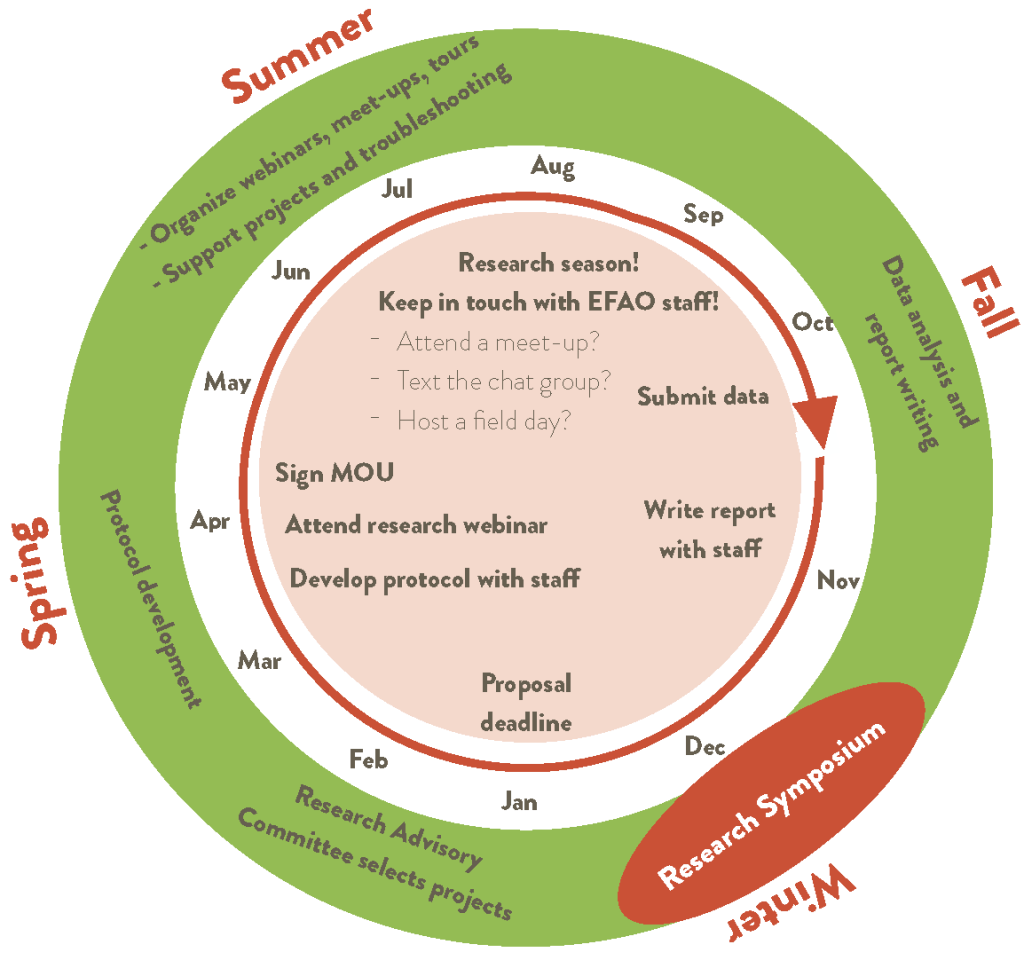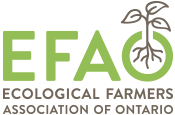By Sarah Hargreaves
This article was originally published in the Summer 2021 issue of Ecological Farming in Ontario, EFAO’s print publication. The print publication is one of several benefits of EFAO Membership.

Activities in the orange circle represent farmer-researcher responsibilities, and activities in the green circle represent EFAO staff activities.
One of the gifts of farming is how it keeps us connected with the rhythm of the seasons. Similarly, the rhythm of farmer-led research is defined by the seasons – with fluidity and overlap throughout.
WINTER is the season for dreaming and planning
The darker months bring you inside to plan for management changes, develop new ideas and ruminate on the results of a previous trial. Winter is also the time to consult with EFAO staff for feedback on your research ideas, and apply for funding before the January 31 deadline. In early February, EFAO’s Research Advisory Committee, made up of EFAO member-farmers and academic researchers, meets to select trials for the upcoming research season. Selection is based on available funding, feasibility and practicality of the proposal, as well as equity, diversity and inclusion goals.
In recognition of your time and the space used for your research, financial support for farmer-led research includes a stipend. For most trials, the stipend is $500; for multi-farm variety trials the stipend ranges from $250-500 depending on the number of replicates and varieties you are trialing. In addition to the stipend, you can receive up to $1,500 in research expenses such as seed, soil or tissue analyses, supplies (like extra harvest crates to keep replicates separate, etc.) and equipment (like scales, etc.).
For trials that overlap calendar years, EFAO commits to funding the trial throughout the duration of the trial. For trials that require an even longer commitment — breeding trials and trials on perennial crops, for example — EFAO will commit up to three years of stipends and expenses assessed on a year-by-year basis depending on available funding.
Along with financial support, EFAO’s Farmer-Led Research Program provides farmer-researchers with technical assistance in experimental design, data collection, analysis and write-up, including EFAO events on farmer-led research like webinars and field days. You are also tapped into the Research Network of other farmer-researchers, for support and inspiration.
SPRING is the season to get ready to grow
If your trial is selected for funding or is continuing from a previous year, you work with EFAO staff to develop a protocol that will guide your research season. This usually involves an initial chat for EFAO staff to gather information to develop a draft protocol, followed by several rounds of tweaking and refining the protocol. What design is both practical and robust? What will you measure and exactly how will you measure it? This is also the time to finalize your list of approved research expenses so you can order supplies as needed. Once the protocol is written, we have a final chat to review the protocol and schedule check-ins throughout the season. At this time, you also review and sign the Memorandum of Understanding (MOU) that covers your responsibilities, EFAO’s responsibilities, photo permission, data sharing and data ownership (in a nutshell: you own you data!)
SUMMER is the season for curiosity
If you are currently tending a research trial on your farm, now is when your project is likely in full swing – and your curiosity meets rigour as you maintain your trial plots and collect data following the protocol that you developed in the spring. This is also the time when, through observation, intuition, and experience you cultivate new curiosities and ideas for potential future trials. For current and ongoing projects, EFAO staff check in about your project, and you can reach out to fellow farmer-researchers through a text group and at meet-ups. When possible, you might host or attend a field day around a past or present farmer-led research trial.
It’s a busy season, but you are prepared. And luckily, EFAO staff work to make farmer-led research a flexible tool that can adapt as needed to the demands, quirks and changes to your growing season.
FALL is the season for harvest
This is when you finish collecting data and reap the benefits of your efforts. The extra work that you’ve taken on as part of your research trial comes to fruition. After sending your data and photos to EFAO staff, we get to work organizing and analyzing your data using free online tools and R software, which is a free open source software and programming language for statistical computing and graphics. Working closely with you, EFAO staff interpret the data you collected — combining quantitative (e.g. harvest weights, etc.) and qualitative (i.e. observations, intuitions) data. This culminates in an accessible (and beautiful!) research report. You can find reports from the 2020 research season at efao.ca/research-2020.
The fall season is also when the research culminates with the Research Symposium, held in conjunction with EFAO’s Annual Conference. This is a space where you share your findings from the year, learn about the other research projects. Conversations with others about these results may create new questions, and the cycle begins again.


